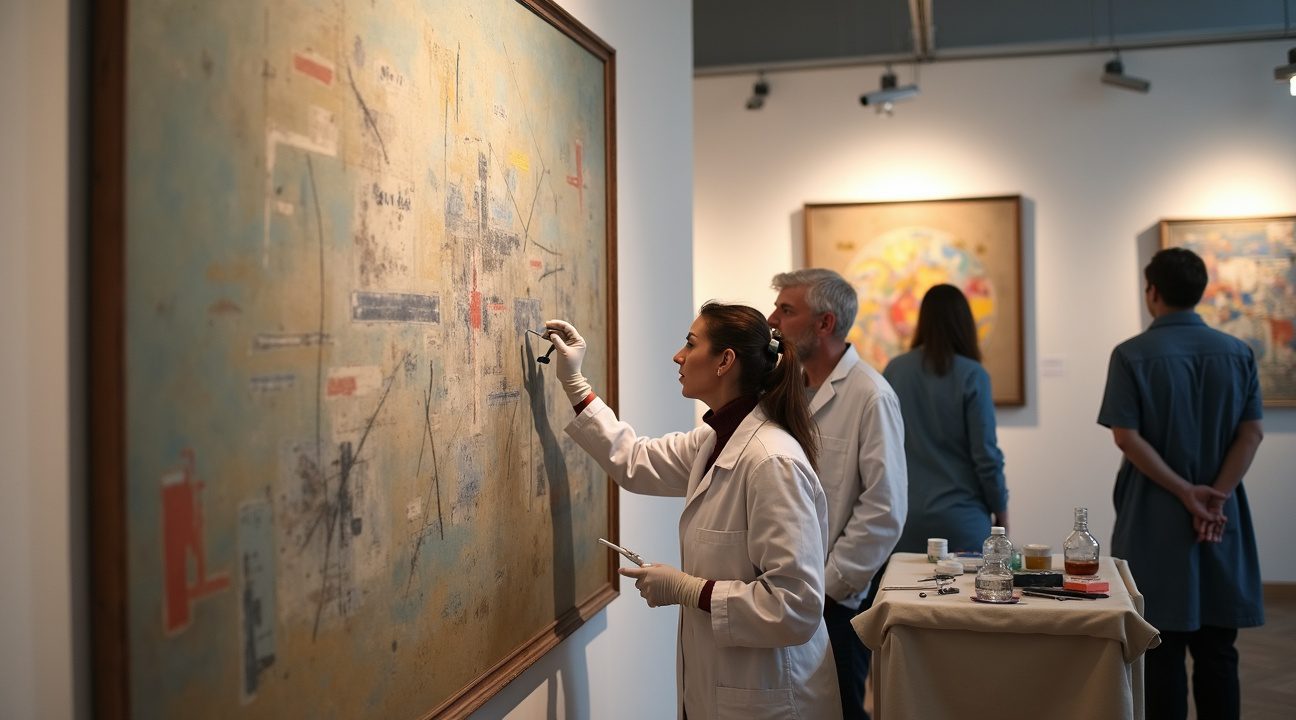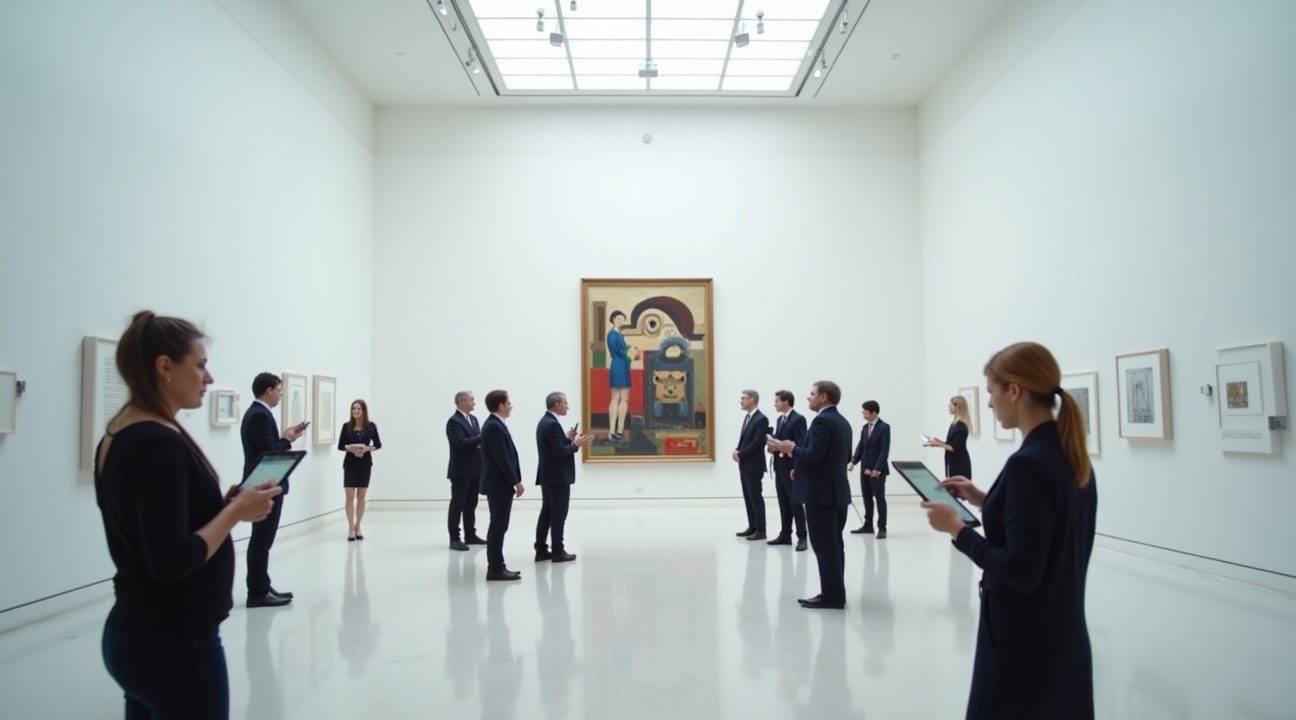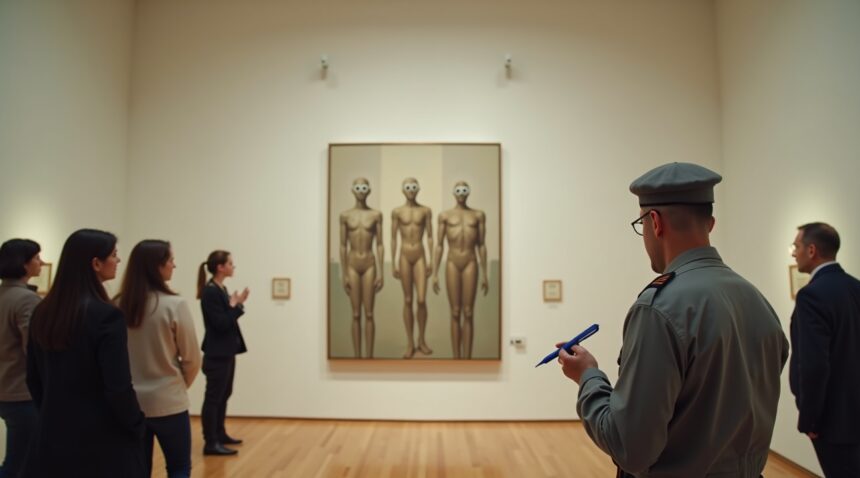A security guard’s unexpected act of vandalism during his very first shift at the Boris Yeltsin Center shocked the art world when he defaced a priceless Russian avant-garde painting by Anna Leporskaya.
The Incident
The painting in question, “Three Figures” (1932–1934), valued at approximately $1 million, featured intentionally faceless characters. Out of boredom, the 60-year-old guard added crude eyes to two of the figures using a ballpoint pen supplied by the museum itself. This act of defacement marked a significant and unfortunate event on his first day of work at the cultural institution.
Restoration and Costs
The painting was successfully restored thanks to the efforts of conservation experts. The damage repair cost approximately $2,500 to $3,400 and was fully covered by the museum’s insurance provider, AlfaStrakhovanie.
Legal and Disciplinary Consequences
As a result of his actions, the security guard received the following penalties:
- 180 hours of compulsory labor
- Mandatory psychiatric evaluation
- He narrowly avoided financial penalties that could have reached the full estimated value of the artwork, which is 74.9 million rubles
Security Gaps and Response
The incident highlighted several lapses in security at the Boris Yeltsin Center. Immediate changes were reportedly implemented:
- Installation of protective display screens for vulnerable artworks
- Upgraded security surveillance systems throughout the premises
- Stricter staff training and hiring protocols to ensure preparedness and professionalism
Broader Impact on the Art World
This event ignited widespread debates and prompted museums and galleries around the globe to re-evaluate their internal operations. Key talking points included:
- Strengthening security measures for high-value artwork
- Improving support and training for museum personnel
- Discussing responsibilities and accountability regarding artwork protection
The conversation extended across international cultural communities and served as a wake-up call for institutions that house vulnerable and irreplaceable works of art.
For more details, you can visit the Boris Yeltsin Center’s official site.
Security Guard Draws Eyes on Faceless Figures During First Day on the Job
December 7, 2021 became a day that museum administrators at the Boris Yeltsin Center in Yekaterinburg, Russia would never forget. A 60-year-old security guard took a ballpoint pen and drew eyes on two of the three faceless figures in Anna Leporskaya’s painting ‘Three Figures’ (1932–1934), permanently damaging the valuable artwork.
The incident occurred during the guard’s very first day on the job at the exhibition titled ‘The World as Non-Objectivity: The Birth of a New Art’. I find it striking that someone entrusted with protecting priceless artwork would make such a destructive decision within hours of starting their position. The guard, employed by a private security company rather than directly by the museum, later told administrators that boredom had motivated his actions.
The Defacement Details
The pen used for the vandalism bore the Yeltsin Center’s own branding, adding an unfortunate irony to the situation. Witnesses described the added eyes as ‘crudely-rendered’, which suggests the guard made no attempt at artistic finesse during his unauthorized addition to Leporskaya’s work. The fact that he chose to draw on only two of the three faceless figures raises questions about his thought process and whether he was interrupted or simply lost interest.
Museum visitors discovered the defacement on the same day it occurred, immediately alerting staff members to the damage. This quick discovery likely prevented any additional alterations, though the harm had already been done to the 1932–1934 painting. The swift reporting by observant visitors demonstrates how engaged audiences can serve as an additional layer of protection for artwork, even when security measures fail.
Administrative Response and Implications
Museum administrators described the guard’s actions as a ‘lapse in sanity’, which suggests they viewed the incident as completely uncharacteristic behavior rather than malicious intent. This perspective aligns with the guard’s own explanation of boredom, though it doesn’t diminish the severity of damaging such a significant piece of art history. Private security companies often face scrutiny about their training protocols and employee screening processes after incidents like this.
The timing of this vandalism during an exhibition celebrating the birth of new art forms adds particular sting to the situation. Leporskaya’s work represented a specific movement in art history, and the unauthorized addition fundamentally altered the artist’s original vision. Much like how entertainment industry incidents can generate unexpected attention — similar to when major film announcements capture public interest — this museum incident sparked widespread discussion about art security protocols.
The Boris Yeltsin Center likely faced significant pressure to review their security procedures following this incident. Art institutions typically require extensive background checks and specialized training for security personnel, given their proximity to irreplaceable cultural artifacts. The fact that this occurred on the guard’s first day suggests potential gaps in orientation procedures or supervision protocols.
Security companies working with museums must balance accessibility for visitors with protection for artwork. Guards often spend long hours in quiet galleries, making proper training and mental preparation essential for preventing incidents born from monotony or poor judgment. The pen’s availability within the exhibition space also raises questions about what materials should be accessible to security personnel during their shifts.
This incident serves as a reminder that human error remains one of the most unpredictable threats to cultural preservation, regardless of technological security measures or institutional protocols.
The Million-Dollar Masterpiece and Its Creator Anna Leporskaya
Anna Leporskaya’s Artistic Legacy
Anna Leporskaya crafted “Three Figures” between 1932 and 1934, creating what would become one of the most significant examples of Soviet avant-garde art. Born in 1900, Leporskaya studied under the influential abstract artist Kazimir Malevich, whose revolutionary approach to modernism shaped her artistic vision. Her work extended beyond traditional canvas painting into artistic porcelain, demonstrating the versatility that made her a respected figure in Soviet art circles until her death in 1982.
Leporskaya’s connection to Malevich positioned her within a movement that challenged conventional artistic representation. The abstract and geometric elements in her work reflected the broader Soviet avant-garde movement’s attempt to create new visual languages that broke from traditional forms. Her artistic approach combined the theoretical foundations she learned from Malevich with her own unique interpretation of modernist principles.
The Cultural and Financial Value of “Three Figures”
The State Tretyakov Gallery in Moscow loaned “Three Figures” with an insurance valuation of approximately $1 million, equivalent to roughly 74.9 million rubles. This substantial monetary value reflects both the artwork’s historical significance and its rarity within the context of Soviet modernist art. Few works from this period survived the political upheavals that often targeted avant-garde artists and their creations.
Beyond its impressive financial worth, “Three Figures” represents a critical piece of Soviet-era modernism that documents an important cultural movement. The painting captures a moment when Russian artists were experimenting with new forms of expression, creating works that would influence generations of artists. Its faceless figures embody the abstract qualities that defined the era’s artistic rebellion against representational art.
The artwork’s presence in international exhibitions demonstrates how Soviet avant-garde pieces have gained recognition far beyond their country of origin. Museums worldwide seek these works for their collections, understanding that pieces like “Three Figures” offer viewers insight into a transformative period in art history. The painting’s loan arrangement with international institutions reflects the growing appreciation for Soviet modernist works in global art markets.
I find it fascinating how entertainment culture continues to evolve while classical artworks like Leporskaya’s maintain their enduring appeal across decades. The contrast between contemporary media and historical art pieces highlights how different forms of cultural expression serve various audiences and purposes.
The historical context surrounding “Three Figures” adds layers of meaning that extend far beyond its visual elements. Created during a period when Soviet artists faced increasing pressure to conform to state-approved artistic styles, Leporskaya’s work represents both artistic courage and cultural documentation. The painting stands as evidence of the creative spirit that persisted despite political constraints.
Collectors and art historians value pieces from this era because they capture a unique moment when Russian artists were pushing boundaries while operating within an increasingly restrictive political environment. The survival of works like “Three Figures” allows contemporary audiences to understand the complexity of artistic expression during the Soviet period. Each brushstroke and compositional choice reflects decisions made by an artist working within specific historical circumstances that shaped her creative output.
Restoration Experts Assess the Ballpoint Pen Damage
Art restoration specialists quickly evaluated the extent of damage caused by the security guard’s ballpoint pen additions to the valuable artwork. The experts discovered that the ink had penetrated slightly into the paint layer, creating a concerning but manageable situation for the restoration team.
The painting’s composition worked in favor of the restoration process. Many abstract works from this particular era lack protective varnish coatings, and this piece followed that typical characteristic. Without a varnish barrier, the ballpoint pen marks made direct contact with the paint surface, but paradoxically, this absence of protective coating made the damage completely reversible through professional intervention.
Cost and Insurance Coverage
Professional restoration services estimated the repair costs between $2,500 and $3,400, equivalent to approximately 250,000 rubles. The insurance company AlfaStrakhovanie stepped forward to cover these expenses, ensuring the artwork’s full restoration without financial burden on the gallery or artwork owner. This coverage highlights the importance of comprehensive insurance policies for high-value artworks in public exhibitions.
Gallery administrators learned valuable lessons from this incident. They’ve since implemented protective screens around other displayed works throughout the exhibition space. These preventive measures aim to maintain appropriate viewing distances while safeguarding artworks from potential vandalism or accidental damage. The protective barriers allow visitors to appreciate the pieces fully while creating a physical buffer between the public and irreplaceable cultural treasures.
The restoration process required specialized techniques to carefully remove the ballpoint pen ink without damaging the original paint layers beneath. Conservation experts used precise chemical treatments and mechanical methods to lift the foreign ink while preserving the artist’s original work. This delicate procedure demanded extensive knowledge of both the artwork’s materials and modern restoration chemistry.
Security protocols also received updates following the incident. Enhanced monitoring systems and revised staff training programs now emphasize the critical importance of professional conduct around valuable artworks. These changes reflect the gallery’s commitment to protecting cultural heritage while maintaining public access to significant artistic works.
The successful restoration demonstrates how professional expertise can reverse even concerning damage to valuable artworks. Modern conservation techniques continue advancing, offering hope for preserving cultural treasures against various threats, whether from environmental factors, accidents, or human interference.

Criminal Charges and Sentencing for Art Vandalism
The security guard’s impulsive decision to draw eyes on the faceless figures resulted in immediate termination and serious legal consequences. Authorities swiftly moved to prosecute the individual under vandalism statutes, recognizing the severity of damaging a million-dollar artwork.
Legal Penalties and Sentencing
The court imposed a sentence of 180 hours of compulsory labor, requiring the former guard to perform unpaid community service. Additionally, the judge mandated a psychiatric evaluation to assess the defendant’s mental state and determine if underlying psychological factors contributed to the destructive behavior.
Prosecutors initially considered a broader range of penalties that demonstrated the serious nature of art vandalism crimes:
- Monetary fines spanning from $537 up to the painting’s complete valuation of 74.9 million rubles
- Potential one-year prison sentence for property destruction
- Alternative correctional labor programs as substitutes for incarceration
- Restitution payments to cover restoration costs and damages
The financial exposure alone could have bankrupted the individual, as courts sometimes require vandals to compensate for the full market value of destroyed artworks. However, the final sentence reflected consideration of the defendant’s apparent lack of malicious intent and possible mental health factors.
This case highlights how art vandalism carries surprisingly harsh penalties compared to other property crimes. Museums and galleries invest enormous resources in acquiring and preserving cultural treasures, making any damage particularly devastating. Similar to how public figures face scrutiny for their actions, institutions must now answer for security lapses that allow such incidents.
The Yeltsin Center faced intense criticism following the vandalism, with investigators questioning how an employee could access artwork without proper supervision. The incident exposed significant gaps in the museum’s security protocols and staff vetting procedures. Management immediately implemented stricter hiring practices, including enhanced background checks and psychological screening for positions involving direct contact with valuable exhibits.
The center also revised its exhibition security measures, installing additional monitoring systems and establishing clearer protocols for staff interaction with artworks. These changes reflect industry-wide concerns about protecting cultural assets from both external threats and internal risks posed by employees with access to precious collections.
Insurance companies covering the damaged painting likely conducted their own investigations, as such incidents can impact future coverage rates and policy terms for cultural institutions. The financial ramifications extended beyond the immediate restoration costs, affecting the museum’s reputation and potentially limiting future exhibition opportunities with prestigious lenders.
Art law experts noted that this case demonstrates the complex intersection of criminal law, employment regulations, and cultural preservation. The psychiatric evaluation requirement acknowledges that destructive behavior toward art sometimes stems from mental health issues rather than criminal intent, though this doesn’t absolve perpetrators of responsibility.
The sentencing also serves as a deterrent to other museum employees who might consider similar actions. Cultural institutions worldwide referenced this case when updating their own security training programs and employee conduct policies. The incident reminds us that even momentary lapses in judgment can result in irreversible damage to humanity’s artistic heritage.
Legal precedents from similar cases suggest that repeat offenders or those who cause damage with clear criminal intent face much harsher sentences, including substantial prison terms. The relatively lenient outcome in this instance likely reflected the defendant’s clean record and the spontaneous nature of the vandalism rather than premeditated destruction.
Museum Security Failures Spark International Discussion
This incident ignited widespread debate across the international art community about fundamental gaps in museum security protocols. I’ve observed how major cultural institutions worldwide began reassessing their protective measures following this shocking breach of trust. The case exposed vulnerabilities that many had assumed were impossible in professional gallery settings.
Global Response and Media Attention
The story captured international headlines, bringing unexpected attention to Anna Leporskaya’s artistic legacy. Media outlets highlighted her significance as a pioneering figure in Russian avant-garde art and her connection to the legendary Kazimir Malevich. This coverage inadvertently provided valuable exposure to an artist whose work had remained relatively unknown outside academic circles.
Art critics and museum professionals used this incident to discuss broader issues affecting cultural preservation. The conversation extended beyond security failures to encompass questions about staff training, visitor supervision, and the psychological pressures faced by gallery employees. Social media amplified these discussions, with art enthusiasts sharing their own experiences and concerns about museum practices.
Institutional Changes and Preventive Measures
The Yeltsin Center faced immediate pressure to address its security shortcomings following intense global scrutiny. Management implemented comprehensive reforms designed to prevent similar incidents from occurring in the future. These changes included:
- Enhanced surveillance systems
- Stricter staff protocols
- Improved training programs for security personnel
The institution also revised its policies regarding loaned artworks, recognizing the special responsibility that comes with displaying pieces from other collections. I’ve noticed how this incident influenced other museums to review their own procedures, particularly those hosting traveling exhibitions. The ripple effects extended throughout the museum community, prompting discussions about industry standards and best practices.
Insurance companies took notice of this case, with some adjusting their policies for cultural institutions. The financial implications of such security breaches became a focal point for museum administrators seeking to balance accessibility with protection. This incident demonstrated how quickly a moment of poor judgment can result in devastating consequences for both the artwork and the institution’s reputation.
Contemporary discussions about museum security now frequently reference this case as a cautionary tale. The event highlighted the human element in art preservation, reminding professionals that even the most sophisticated systems depend on individual responsibility and judgment. Similar to how high-profile apologies can reshape public perception, the Yeltsin Center’s response became a model for institutional accountability in crisis situations.
The international art community used this opportunity to advocate for better working conditions and mental health support for museum staff. Experts argued that preventing such incidents requires addressing the underlying factors that might lead employees to act destructively. This perspective shifted the conversation from punishment to prevention, emphasizing the importance of creating supportive work environments.
Professional associations and museum networks developed new guidelines for security training and staff well-being programs. The incident catalyzed discussions about the isolation and stress that can affect museum workers, particularly those in security roles who spend long hours in relative solitude. These conversations led to practical improvements in how institutions support their employees while maintaining the highest standards of artwork protection.

Sources:
Business Insider – Security guard accused of ruining million-dollar painting by doodling eyes
The Art Newspaper – Russian gallery guard charged after drawing eyes on avant-garde painting with ballpoint pen
Daily Sabah – Bored Russian gallery guard draws eyes on million-dollar painting
ArtDependence – $1 Million Painting Vandalised After Bored Security Guard Draws Eyes on Faceless Figures
The Art Newspaper – Russian guard who doodled eyes on $1m painting sentenced as scrutiny of museum intensifies
Artnet News – Russian Museum Guard Damaged Painting


